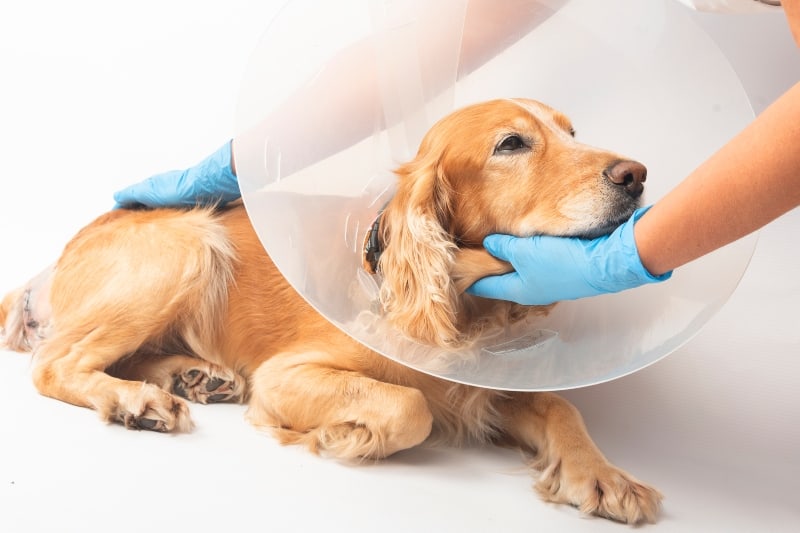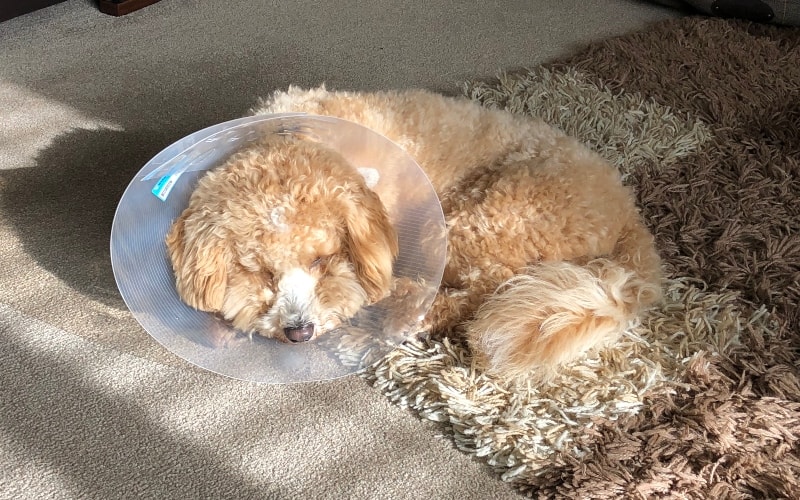Every pet parent wants the best for their fur-friend. Therefore the decision about desexing male dogs or getting a female dog spayed weighs heavy on an owner’s mind.
It’s difficult to tune out the background noise of personal opinion when thinking through the pros and cons of desexing dogs. Then there are emotional factors that come into play.
An observation on human nature is that as a vet I find male owners much less willing to even discuss desexing male dogs than getting a female dog spayed! Go figure what that’s about!
With your pet’s health and well-being depending on your decision, let’s open up a discussion and give sensible answers.
What’s the Difference between Spaying and Neutering?
OK, it’s difficult to quiz your vet when you aren’t confident about what to ask about. I’ve heard a whole colorful dictionary of euphemisms (but none of the amusing ones are printable!)
In the US the generally accepted terms are:
- Desexing: Is gender neutral and refers to the process of removing the dog’s reproductive parts
- Spaying: This refers to desexing a female dog
- Neutering: The term for desexing a male dog (also more clearly known as castration.) The waters can get a little muddy, because neutering is considered a gender neutral term in some countries. Thus, the UK talks about neutering or spaying females, and castrating males. Confusing or what!
In short, you can’t go wrong:
If you have a girl dog then ask about spaying.
If you have a boy dog, ask about neutering.

Is Desexing Cruel?
Great question!
This is a welfare debate with many lines of thought to pursue.
On the one hand desexing alters the dog and prevents them participating in natural behaviors. This includes mating, roaming, pregnancy, and giving birth. Some people feel uncomfortable about this.
On the other hand, dogs have different emotional needs to people. They don’t crave a family or feel depressed because they can’t have pups. So another view is that it’s wrong to ‘anthropomorphosis’ or assign human emotions to dogs.
There’s also an argument that pregnancy and birth can be confusing for a pet and cause physical or emotional distress. So spaying a female saves her from potential harm.
So no, desexing isn’t cruel, but you do need to think through the implications and arrive at your own conclusion.
What does Neutering Involve?
Vets use a great premed protocol which combines different types of pain relief. This ensures your pet stays comfortable before, during, and after their surgery. Whether male or female, the dog will be asleep, under general anesthetic for the operation.
Desexing male dogs involves surgical removal of both testicles. This is usually done through a single skin incision, just in front of the scrotum. The wound itself is surprisingly small, at just 2-3cm long.
The recovery period is around 10 – 14 days. During this time the dog should rest and possibly wear an e-collar (the dreaded cone of shame). This reduces the risk of complications such as a swollen scrotum or wound infection.
What Does Spaying Involve?
Getting a dog spayed is a bit more invasive, because the vet has to open up into her tummy.
Most vets perform an ‘ovariohysterectomy’, which means removing both the uterus and the ovaries. However, some vets now do a less invasive procedure called ‘ovarectomy’ where just the ovaries are removed. This can be done endoscopically, which means a smaller incision and less potential for discomfort.
Again, the recovery time is around 10-14 days, during which the dog must have strict rest. It’s important she doesn’t over do things as this could cause internal ligatures to slip.
What are the Advantages of Desexing Dogs?
The most obvious advantage is that desexing dogs helps population control. With rescues overflowing with beautiful dogs in desperate need of loving homes, there are strong ethical arguments for not adding to the doggy over pup-lation.
But what if you are a highly responsible owner who never lets their dog out of their sight?
Consider the health benefits of having a dog spayed or neutered.
For the females, the advantages are:
- No to Pyometra: Pyometra is a potentially life-threatening condition. It is when the womb fills with pus, making the dog septic, and sending her into kidney failure. Removing the womb (or just the ovaries) prevents this.
- No more Seasons: A female dog in heat can be difficult to cope with. From the bloody discharge to the attention of male dogs, managing a dog in estrus is a trial and no mistake.
- Reduced Risk of Mammary Cancer: Get a female dog spayed before her second season and this hugely reduces her risk of developing breast cancer. Leave surgery until after this time and her chances of growing a mammary tumor are one-in-four.
So what about the boys?
- More Manageable: Some male dogs are martyrs to their hormones. High levels of testosterone can make them overly sexed, protective, or territorial; with the latter manifesting itself as aggression. For SOME dogs (but not all), neutering can help.
- Reduced Prostatic Disease: An older male dog can develop an enlarged prostate. Whilst the condition can be treated, desexing can prevent it.
- No to Testicular Cancer: With the testicles removed there’s no risk of cancer.

What are the Disadvantages of Desexing Dogs?
For every pro there are cons, so let’s look at these.
The downsides of desexing dogs are:
- Increased Health Problems: There is increasing evidence that desexing SLIGHTLY increases the risk of certain health conditions. Sadly, some of these problems are serious, such as bone cancer. Also, some can be costly (and painful) to correct, such as ruptured cruciate ligaments. However, this again needs discussing with your vet because breed plays a part, as does age at neutering; plus the increased risk is a fraction of a percent.
- For the Females: There’s a slight increase in the risk of urinary incontinence in later life. This can be treated with daily medication.
- For the Males: There a slight increased risk of prostate cancer. Also, for a dog with low self-confidence, removing their supply of testosterone can make them more nervous or anxious, which can lead to increased aggression. This is why it’s important to talk through your reasons for surgery with a vet, because what’s advisable for one dog may not be right for another.: There a slight increased risk of prostate cancer. Also, for a dog with low self-confidence, removing their supply of testosterone can make them more nervous or anxious, which can lead to increased aggression. This is why it’s important to talk through your reasons for surgery with a vet, because what’s advisable for one dog may not be right for anothe
What is the Recommended Age for Desexing Dogs?
Again this is a moveable feast, with no absolute right or wrong answer.
For the female dogs, it’s great to grab the benefit of desexing before the second season happens. This then protects against mammary cancer.
For the boy dogs, in an ideal world it’s nice to let them mature a bit ahead of surgery, say at 10 months. However, advice varies widely and early neutering (10 – 12 weeks) is often performed at rescues.
Does Desexing Stunt Growth?
How does early desexing affect dogs?
Far from stunting growth, early spaying or neutering can lead to taller dogs.
This is because the growth plates in the long bones stay active for longer. As the name suggests, the growth plates are the areas from which bones elongate. There’s something about the absence of high levels of sex hormones which means these vital areas stay working for long.
The result is taller, lankier dogs.
What Changes Can you Expect Afterwards?
Don’t expect desexing to be a miracle answer for a badly behaved dog. There’s no substitute for effective training and an understanding dog psychology. However, desexing dogs can help rein in an unruly dog, say a male that’s constantly distracted by females in heat.
Pooch Personality
A common fear from many owners is that desexing will alter their dog’s personality. This is unlikely to happen. The dog’s character runs right through them, like lettering in a stick of rock, and slightly reduced levels of hormones doesn’t change this.
What About the Weight Issue?
A desexed pet’s metabolic rate slows down a fraction. But we are talking small scale, such as around 5%. Thus, to avoid weight gain, simply cut their food by 5% after they’ve recovered from surgery.
Alternatively, if you don’t reduce their ration, then the waistline may slowly expand. This is just like if we eat a candy bar each day, on top of our regular meals. Over the weeks and months those pounds slowly pile on until one day our pants don’t fit…
Fluffy Fur
Some breeds, such as Golden Retrievers, may see a coat change further down the line. Some dogs go from sleek silky hair to fluffy fur.
Desexing Dogs: To Do or Not to Do?
Always make an informed decision, which involves chatting to your vet. Remember, all dogs are individuals. What is best for one may not be desirable for another.
If in doubt, sit down with a piece of paper and list the pros and cons for you pooch. Have a family discussion, and then talk through the points with your vet.

